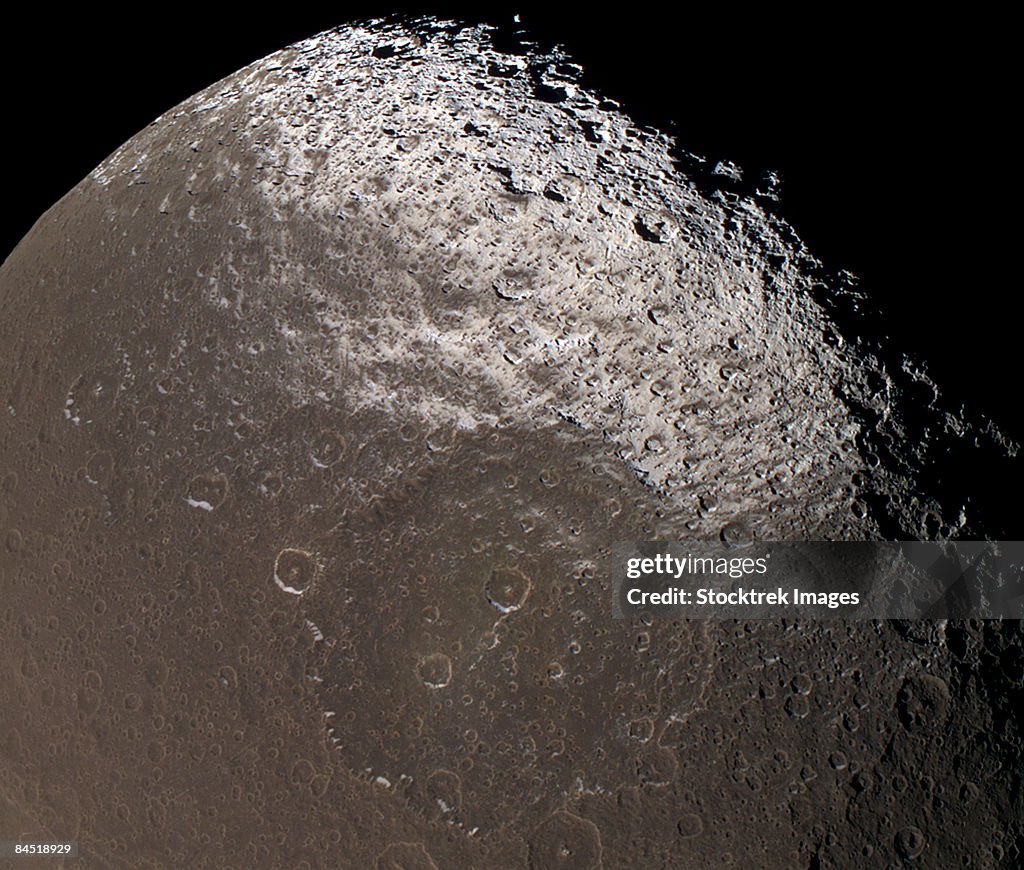Saturn's moon Iapetus. - stock photo
December 31, 2004 - Dark-stained Iapetus. This near-true color view from Cassini reveals the colorful and intriguing surface of Saturn's moon Iapetus in unrivaled clarity. The use of color on Iapetus is particularly helpful for discriminating between shadows (which appear black) and the intrinsically dark terrain (which appears brownish). This image shows the northern part of the dark Cassini Regio and the transition zone to a brighter surface at high northern latitudes. Within the transition zone, the surface is stained by roughly north-south trending wispy streaks of dark material. The absence of an atmosphere on Iapetus means that the material was deposited by some means other than precipitation, such as ballistic placement from impacts occurring elsewhere on Iapetus, or was captured from elsewhere in the Saturn system. Iapetus's north pole is not visible here, nor is any part of the bright trailing hemisphere. Images taken with infrared (centered at 930 nanometers), green (568 nanometers), and ultraviolet light (338 nanometers) filters were combined to create this image. The view was obtained with the Cassini spacecraft narrow angle camera on December 31, 2004, at a distance of about 172,900 kilometers (107,435 miles) from Iapetus.

Get this image in a variety of framing options at Photos.com.
PURCHASE A LICENSE
All Royalty-Free licenses include global use rights, comprehensive protection, simple pricing with volume discounts available
€300.00
EUR
Getty ImagesSaturns Moon Iapetus High-Res Stock Photo Download premium, authentic Saturn's moon Iapetus. stock photos from 51łÔąĎÍř Explore similar high-resolution stock photos in our expansive visual catalogue.Product #:84518929
Download premium, authentic Saturn's moon Iapetus. stock photos from 51łÔąĎÍř Explore similar high-resolution stock photos in our expansive visual catalogue.Product #:84518929
 Download premium, authentic Saturn's moon Iapetus. stock photos from 51łÔąĎÍř Explore similar high-resolution stock photos in our expansive visual catalogue.Product #:84518929
Download premium, authentic Saturn's moon Iapetus. stock photos from 51łÔąĎÍř Explore similar high-resolution stock photos in our expansive visual catalogue.Product #:84518929€300€40
Getty Images
In stockDETAILS
Credit:
51łÔąĎÍř #:
84518929
License type:
Collection:
Stocktrek Images
Max file size:
3424 x 2910 px (11.41 x 9.70 in) - 300 dpi - 5 MB
Upload date:
Release info:
No release required
Categories: